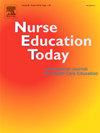探索撒哈拉以南非洲两个国家护士教育工作者对医疗保健相关感染预防和控制的经验和看法:一项探索性质的研究
IF 4.2
2区 医学
Q1 EDUCATION, SCIENTIFIC DISCIPLINES
引用次数: 0
摘要
目的探讨撒哈拉以南非洲两个国家护理教育工作者在预防和控制卫生保健相关感染方面的经验和看法。设计定性描述性研究。方法采用多模式分析方法对医院相关性感染现状进行调查。与教育工作者(n = 24)进行了深入访谈,以获得全面的见解,并与学术和临床教育工作者(n = 96)进行了14次焦点小组讨论。采用内容分析法对收集到的资料进行分析。结果确定了“感染预防与控制教育”这一大类,共分为5个大类和12个小类。主要研究结果强调了护理教育中的教学挑战,这些挑战源于理论与实践之间的不平衡,以及用于感染控制培训的时间不足。与会者指出,讲师和临床讲师之间的合作存在差距,而且在所有学习环境中都缺乏设备,这阻碍了卫生保健方案的实施,并限制了两个SSA国家感染预防和控制措施的有效性。解决已确定的教学挑战,加强护理教育工作者之间的合作,提供足够的设备,并制定适应环境的感染预防模式,对于改善撒哈拉以南非洲这两个国家的教育和实践至关重要。本文章由计算机程序翻译,如有差异,请以英文原文为准。
Exploring nurse educators' experiences and perceptions of healthcare-associated infection prevention and control in two countries of sub-Saharan Africa: An exploratory qualitative study
Aim
To explore the experiences and perceptions of nurse educators about prevention and control of healthcare-associated infections in two countries of Sub-Saharan Africa.
Design
Qualitative descriptive study.
Methods
A multimodal approach was employed to investigate the reality of hospital-associated infections. In-depth interviews were conducted with educators (n = 24) to gain comprehensive insights, and 14 focus group discussions were facilitated with academic and clinical educators (n = 96). Collected data was analysed using the content analysis method.
Results
It was identified one major category, “Education about Infection Prevention and Control,” with five categories and twelve subcategories. Key findings highlighted pedagogical challenges in nursing education stemming from the imbalance between theory and practice, coupled with insufficient hours dedicated to infection control training. Participants noted gaps in the collaboration between lecturers and clinical instructors, as well as a lack of equipment in all the learning contexts, hindering the HAI protocols and limiting the effectiveness of infection prevention and control measures in both SSA countries.
Conclusion
Addressing the identified pedagogical challenges, enhancing collaboration between nursing educators, providing adequate equipment, and developing a contextually adapted model for infection prevention is essential for improving education and practices in both countries of Sub-Saharan Africa.
求助全文
通过发布文献求助,成功后即可免费获取论文全文。
去求助
来源期刊

Nurse Education Today
医学-护理
CiteScore
6.90
自引率
12.80%
发文量
349
审稿时长
58 days
期刊介绍:
Nurse Education Today is the leading international journal providing a forum for the publication of high quality original research, review and debate in the discussion of nursing, midwifery and interprofessional health care education, publishing papers which contribute to the advancement of educational theory and pedagogy that support the evidence-based practice for educationalists worldwide. The journal stimulates and values critical scholarly debate on issues that have strategic relevance for leaders of health care education.
The journal publishes the highest quality scholarly contributions reflecting the diversity of people, health and education systems worldwide, by publishing research that employs rigorous methodology as well as by publishing papers that highlight the theoretical underpinnings of education and systems globally. The journal will publish papers that show depth, rigour, originality and high standards of presentation, in particular, work that is original, analytical and constructively critical of both previous work and current initiatives.
Authors are invited to submit original research, systematic and scholarly reviews, and critical papers which will stimulate debate on research, policy, theory or philosophy of nursing and related health care education, and which will meet and develop the journal''s high academic and ethical standards.
 求助内容:
求助内容: 应助结果提醒方式:
应助结果提醒方式:


